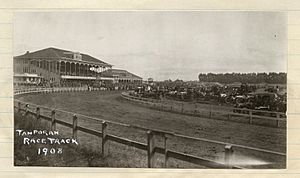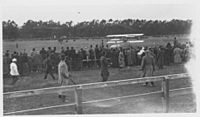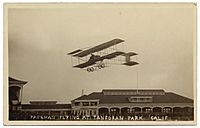Tanforan Racetrack facts for kids
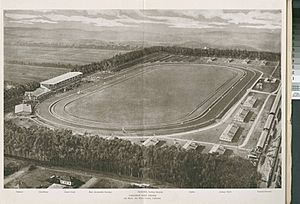
Tanforan Racetrack
|
|
| Location | San Bruno, California, United States |
|---|---|
| Coordinates | 37°38′08″N 122°25′09″W / 37.6354361°N 122.4190361°W |
| Date opened | November 4, 1899 |
| Date closed | July 31, 1964 (fire) |
| Course type | Flat for Thoroughbreds |
| Notable races | Tanforan Handicap |
Tanforan Racetrack, also known as Tanforan Park, was a place in San Bruno, California, where people watched horse races. It was located on the San Francisco Peninsula in California. The racetrack was open from November 4, 1899, until 1964. It was built to serve people from nearby San Francisco.
Between April and October 1942, the racetrack became the Tanforan Assembly Center. This was a camp where about 8,000 Bay Area Japanese Americans were held. They were forced to leave their homes and live there before being moved to larger camps.
A fire destroyed the racetrack on July 31, 1964. Today, a shopping center called The Shops at Tanforan stands on the site. The mall has a special plaque about the racetrack's history. It also has a garden to remember the Tanforan Assembly Center and a statue of the famous horse Seabiscuit.
History of Tanforan Racetrack
Early Days and Challenges
The Tanforan site was chosen because it was outside San Francisco. At the time, gambling was banned in San Francisco, which had closed other racetracks. A group of investors, including banker William H. Crocker, decided to build a new track here. They bought 150 acres of land in San Bruno in 1899.
The new racetrack was named after Toribio Tanforan. He was related to the original owner of the land. About 700 workers helped build the track and its main building, called the grandstand.
The track, first called Tanfaran Park, opened on November 4, 1899. It had a 1-mile oval track. The grandstand could seat 3,000 people and hold up to 5,000 visitors. Trains from San Francisco stopped right in front of the grandstand, making it easy for people to visit. The track's name quickly changed to Tanforan Park.
In its early years, the racetrack faced many problems. There were disagreements between the owners of different racetracks. Gambling bans also caused the track to close and reopen several times. Because of these issues, Tanforan Park was used for other things too. These included dog shows, motorcycle races, and car races.
Air Meets and World War I
In January 1910, Tanforan Park hosted the San Francisco International Air Meet. This was only the second aviation event in the United States. Famous pilots like Louis Paulhan and John Joseph Montgomery attended. On January 24, Paulhan made the first recorded flight in northern California. He flew 12 miles in 12 minutes. The next day, 30,000 people watched him fly.
A year later, in January 1911, another air meet was held. This time, a new airfield called Selfridge Field was used. It was across from Tanforan Park. Military members also took part, showing how airplanes could be used in war. Pilots shot at targets and dropped practice bombs.
The 1911 Air Meet had many "firsts" in aviation:
- On January 15, the first aerial bombing in the U.S. happened. A pilot dropped a live bomb from 500 feet, landing it very close to the target.
- The next day, the first aerial reconnaissance flight took place. Pilots tried to find ground troops from the air.
- On January 18, pilot Eugene Burton Ely took off from Tanforan. He then landed his plane on the USS|Pennsylvania|ACR-4|6, a warship in San Francisco Bay. This was the first successful landing of an aircraft on a ship. It helped lead to today's aircraft carrier technology. Later that day, Ely took off from the ship and flew back to Tanforan.
- Finally, on January 21, the first air-to-ground wireless radio message was sent from a plane.
A third air meet happened at Tanforan Park starting in December 1912. Local pilots like Lincoln Beachey performed amazing stunts. Beachey even raced his airplane against a car and a motorcycle.
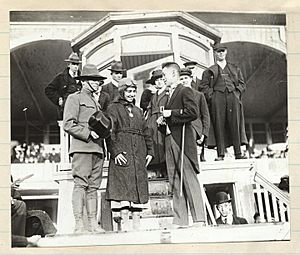
During World War I in 1917, Tanforan was used as a training center for the U.S. military. A volunteer regiment called the "Grizzlies" trained there. To help raise money for the soldiers, pilot Katherine Stinson flew to the track in December 1917. She set a record by flying 610 miles nonstop from San Diego.
Rebuilding and Revival
After 1911, horse racing stopped at Tanforan Park due to a statewide gambling ban. The main buildings were taken down in 1918.
The track was rebuilt in 1922 and reopened for racing in 1923 and 1924. This time, there was no betting allowed. The new grandstand could seat 5,000 people. Before racing started, the track hosted a barbecue to celebrate the Pony Express. A rodeo was also held, with famous actors Douglas Fairbanks and Mary Pickford attending.
Running the track without betting was expensive, so it closed again. It was used for other events, including car races. In the late 1920s, a new type of betting called "option" betting was introduced. This helped the track operate more regularly.
In 1933, the California Horse Racing Board was created to manage horse racing and betting in California. This allowed parimutuel betting (where all bets are pooled together) to become legal. In 1934, Tanforan was rebuilt again. It held a full racing season for the first time in many years. Famous Hollywood film director Frank Capra even filmed scenes for two of his movies, Broadway Bill (1934) and Riding High (1950), at Tanforan Park.
Tanforan Assembly Center during World War II
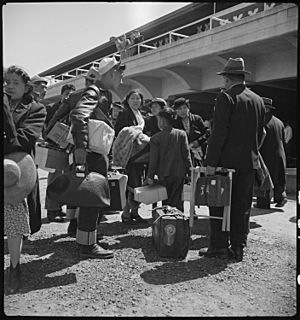
In April 1942, during World War II, Tanforan Park was taken over by the government. It became the Tanforan Assembly Center. From April to October 1942, about 7,800 Japanese Americans from the San Francisco Bay Area were held there. Most of them were U.S. citizens by birth. This happened after Executive Order 9066 was signed, which forced Japanese Americans to leave their homes.
The people held at Tanforan lived in temporary barracks, converted horse stalls, and the grandstand. Tanforan was one of several temporary camps. These camps were chosen to be "close to home" so people could sort out their affairs. They also helped people get used to living in groups while larger, permanent camps were being built. Life at Tanforan was very hard. People faced problems with cleanliness, food, and a lack of privacy and freedom.
Starting in September 1942, the people held at Tanforan were moved by train to the Topaz War Relocation Center in Utah. After October 13, the site was given to the United States Army, and then to the Navy. The site was used by the military for the rest of World War II. Today, Tanforan and other similar centers are recognized as California Historical Landmarks. There are memorial plaques at the site, and a new memorial is planned.
Return to Racing and Final Days
After World War II, in 1945, the site was bought by new owners. They began rebuilding the racetrack in 1946. Despite some legal issues, racing at Tanforan started again on March 14, 1947. At this time, the track's use as an assembly center was not often mentioned.
As the area around San Bruno grew, the racetrack became surrounded by more buildings. It was also under the flight path for San Francisco International Airport. Sometimes, jet planes flying overhead would startle the racehorses.
The track faced a strike in 1957 and a cheating scandal in 1958. In 1959, it was sold to a new group of investors. The last race at Tanforan was held in 1963. In February 1964, the California Horse Racing Board approved the track's closure. Its race dates were moved to other nearby tracks. The 143-acre site was sold in March 1964 to a company that planned to build homes there.
Before the old buildings could be torn down, a fire started at the grandstand on July 31, 1964. The fire spread very quickly. Firefighters from several cities came to help. They managed to stop the fire from spreading beyond the grandstand and clubhouse.
After the fire, the site was cleared. It was then redeveloped into Tanforan Park Shopping Center, which opened in 1971.
Famous Race Competitors
Many famous people in horse racing competed at Tanforan Racetrack. These included owners, breeders, and trainers. For example, trainer Noble Threewitt set a record in April 1954. He won nine races in a row at Tanforan.
In 1932, the great Australian champion horse Phar Lap came to Tanforan. He rested there after a long ocean trip. He then trained at Tanforan before going to Mexico for a big race.
Over the years, many famous horses raced at Tanforan. One of them was Seabiscuit, who is now in the U.S. Racing Hall of Fame. He trained at Tanforan after an injury to prepare for his comeback.
In 1948, another future Hall of Fame horse, Citation, set a new track record at Tanforan. He won the Tanforan Handicap race. Two years later, his stablemate Ponder, who had won the Kentucky Derby, also won the same race.
In 1956, Bobby Brocato won his second straight Tanforan Handicap. That same year, he set a new track record for a 9-furlong race.


